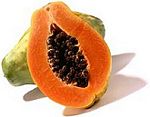Sandbox 31
From Proteopedia
>
| Please do NOT make changes to this Sandbox. Sandboxes 30-60 are reserved for use by Biochemistry 410 & 412 at Messiah College taught by Dr. Hannah Tims during Fall 2012 and Spring 2013. |
Contents |
Papain (PDB ID #: 9pap)
|
Introduction
Papain is a cysteine protease (EC 3.4.22.2) that is found naturally occurring in Papaya(Carica papaya).[1] Papain is extracted from the latex, leaves and roots of the papaya tree.[2] Thiol proteases like papain are commonly found in different fruits like pineapples, figs, and kiwis. Proteases are a group of enzymes that cleave peptide bonds of protein molecules. Papain is a protease commonly used for cell isolation, protein structural studies, cleaving antibodies, and various other research techniques.[2] In addition to use in research, it is commonly used in industry to tenderize meats, remove skin from hides, and clean soft contact lenses.
Physical Properties
Molecular Weight: 23,406 daltons[1] PI: 8.75[2] Optimal pH: 6.0-7.0[1] Optimal temperature: 65 degrees celcius[1]
Structure
Papain is formed from a peptide that is 212 amino acids in length.[3] It consists of 25% and 21% . The structure also consists of three between . The disulfide bonds exist between Cys 63 and Cys 22, Cys 200 and Cys 153, and Cys 56 and Cys 95. Another important residue to the structure is Cysteine 25 which has a sulfhydryl group that plays a major role in the active site activity[[1]].
The in papain are primarily located toward the inside of the enzyme or paired by hydrophobic interactions with other hydrophobic residues to exclude water. The are located facing the exterior, in the active site, or paired with other charged residues. The polar residues seen in orange predominantly fill the space surrounding the exterior of the enzyme. This is because they are hydrophillic and interact with polar water molecules. The charged residues (acidic) and the charged residues (basic) make up the polar residues. The charged and polar residues are hydrophilic therefore do not orient themselves to exclude water or solvent. The charged face outward due to their hydrophilic nature.
Inhibitors
There are many inhibitors of cysteine proteases like papain including antipain, cystatin, Hg2+, and Leupeptin.
Leupeptin (PBD ID #: 1pop)
is a commonly studied inhibitor of proteases (seen in the Jmol as ball and stick model). It inhibits by binding and interacting with the active site which allows it to block the enzyme's desired protein substrate. There are many that interact with Leupeptin in the active site. The predominant interaction is from hydrophobic interactions between Leupeptin and . In addition to hydrophobic interactions, there are also some hydrogen bonding interactions to hold Leupeptin in the active site of papain. Leupeptin works well at blocking papain from its enzymatic duties. A recent study has shown that Leupeptin actually forms a covalent bond between its and CYS 25. In addition, the residues Gln 19 and CYS 25 form with the Leupeptin molecule
Active Site and Mechanism
The active site of papain has a including CYS 25, HIS 159, and ASN 175.
This triad interacts with the substrate to catalyze the reaction. The sulfhydryl group on CYS 25 plays the key role in the mechanism, which is why papain is considered a thiol protease. The sulfur from CYS 25 attacks the backbone amine on the substrate forming a tetrahedral intermediate. Next, the carbonyl is reformed and the carbon nitrogen bond is broken. A water associated with a nitrogen on HIS 159 then attacks the carbonyl forming a second tetrahedral intermediate. The carbonyl then reforms breaking the carbon-sulfur bond. This leaves a carboxy group on the end of one piece of the substrate and an amino group on the end of the other piece.
For a Video Explanation of the Cysteine protease mechanism Click Here.
History
Papain was first explored back in 1873 by G.C. Roy, who studied papaya juice.[2] Later in 1879, the name papain was coined when the papain enzyme was first isolated by Wertz and Bouchut who noticed it had proteolytic properties.[2] Papain was the second enzyme to have it's structure determined by x-ray crystallography.[6] In the 1980s the active site structure was modeled to a 1.65 Angstrom resolution. [7] Extensive research has be done on the structure and activity of papain and its potential medicinal use. This study continues today with study on stability of the papain enzyme and its use as a digestive enzyme supplement.[8]
Medicinal Uses
Papain has been used for a plethora of medicinal purposes including treating inflammation, shingles, diarrhea, psoriasis, parasites, and many others.[9] One major use is the treatment of cutaneous ulcers including diabetic ulcers and pressure ulcers.[10] Pressures ulcers plague many bed bound individuals and are a major source of pain and discomfort. Two papain based topical drugs are Accuzyme and Panafil, which can be used to treat wounds like cutaneous ulcers.[11]
Papain in The News
A recent New York Times article featured papain and other digestive enzymes.[12] With the number of individuals suffering from irritable bowel syndrome and other gastrointestinal issues, many people are turning toward natural digestive aid supplements like papain. The author even talks about the use of papain along with a pineapple enzyme, bromelain, in cosmetic facial masks. Dr. Adam R. Kolker (a plastic surgeon) is quoted in the article saying that "For skin that is sensitive, enzymes are wonderful." He bases these claims off the idea that proteases like papain help to break peptide bonds holding dead skin cells to the live skin cells.[13]

References
- ↑ 1.0 1.1 1.2 1.3 http://http://www.sigmaaldrich.com/life-science/metabolomics/enzyme-explorer/analytical-enzymes/papain.html
- ↑ 2.0 2.1 2.2 2.3 2.4 http://www.worthington-biochem.com/pap/default.html
- ↑ http://www.pdb.org/pdb/explore/explore.do?structureId=9PAP
- ↑ http://peds.oxfordjournals.org/content/7/1/75.abstract
- ↑ http://chemistry.umeche.maine.edu/CHY431/Peptidase10.html
- ↑ http://www.ncbi.nlm.nih.gov/pubmed?term=Structure%20of%20papain%20refined%20at%201.65%20p%20resolution
- ↑ http://www.ncbi.nlm.nih.gov/pubmed?term=Structure%20of%20papain%20refined%20at%201.65%20p%20resolution
- ↑ http://www.webmd.com/vitamins-supplements/ingredientmono-69-PAPAIN.aspx?activeIngredientId=69&activeIngredientName=PAPAIN
- ↑ http://www.webmd.com/vitamins-supplements/ingredientmono-69-PAPAIN.aspx?activeIngredientId=69&activeIngredientName=PAPAIN
- ↑ http://www.pbm.va.gov/Clinical%20Guidance/Drug%20Monographs/Papain%20Urea.pdf
- ↑ http://www.pbm.va.gov/Clinical%20Guidance/Drug%20Monographs/Papain%20Urea.pdf
- ↑ http://www.nytimes.com/2012/02/23/fashion/enzymes-once-sidelined-try-to-grab-the-spotlight.html
- ↑ http://www.nytimes.com/2012/02/23/fashion/enzymes-once-sidelined-try-to-grab-the-spotlight.html
- ↑ http://dailyfitnessmagz.com/2011/03/papayas-nutrition-facts/
http://dailyfitnessmagz.com/2011/03/papayas-nutrition-facts/
http://www.sigmaaldrich.com/life-science/metabolomics/enzyme-explorer/analytical-enzymes/papain.html
http://www.pdb.org/pdb/explore/remediatedSequence.do?structureId=9PAP
